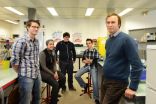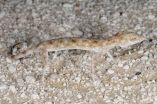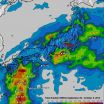Probiotic yogurt could help protect against heavy metal poisoning
Research shows probiotic strain prevents uptake of mercury and arsenic in children and pregnant women in Tanzania
2014-10-07
(Press-News.org) LONDON, ON – New research shows probiotic yogurt can reduce the uptake of certain heavy metals and environmental toxins by up to 78% in pregnant women. Led by Scientists at Lawson Health Research Institute's Canadian Centre for Human Microbiome and Probiotic Research, this study provides the first clinical evidence that a probiotic yogurt can be used to reduce the deadly health risks associated with mercury and arsenic.
Environmental toxins like mercury and arsenic are commonly found in drinking water and food products, especially fish. These contaminants are particularly high in areas where mining and agriculture are prevalent, and in the developing world where regulations for industrial activities are limited or poorly enforced. Even at low levels, chronic exposure to heavy metals has been linked to certain cancers and delayed neurological and cognitive development in children. Yet in Canada, 15% of reproductive-aged women possess mercury levels that pose a high risk for neurodevelopmental abnormalities in their children.
Research suggests some naturally occurring bacteria in the body can influence toxic metal levels. Lactobacillus rhamnosus GR-1 is a probiotic strain that has already been used safely and effectively in yogurt in Canada with positive immune benefits. Previous lab research at Lawson showed it can also bind to heavy metals, but clinical research was needed to confirm whether this mechanism would prevent the body from absorbing them.
In the study, Dr. Gregor Reid, a Scientist at Lawson and Western University, and Jordan Bisanz and Megan Enos, trainees at Lawson and graduate students at Western, assessed 44 school-aged children and 60 pregnant women living in Mwanza, Tanzania near Lake Victoria. This area is known for having particularly high environmental pollution. Tanzania is also home to a network of community yogurt kitchens previously set up with the scientists to provide a locally-sourced, low-cost source of nutrition. The goal of the study was to assess existing metal levels in the environment and participants' bodies, map their natural bacteria to identify any potential links to metal absorption, and determine whether the probiotic-supplemented yogurt could influence metal absorption.
The scientists found mercury and lead levels were up to seven times higher than what is typically found in Canadian children. Silver cyprinids, small fish consumed widely in the region, were found to contain especially high levels of mercury and arsenic. DNA sequencing identified two bacteria present in children with the highest concentrations of heavy metals, suggesting the presence of these bacteria may be linked to metal absorption.
After consuming the probiotic-supplemented yogurt, the children showed positive, but not statistically effective, results. The pregnant women showed more dramatic outcomes. The probiotic yogurt protected them from further uptake of mercury by up to 36% and arsenic by up to 78%.
"The findings are exciting for many reasons," says Dr. Reid, senior author on the publication. "First, they show a simple fermented food, easily made by resource disadvantaged communities, can provide benefits in addition to nutrition and immunity. Second, the results are relevant for many parts of the world, including Canada, where exposure to these toxins occurs daily. Finally, it confirms more attention needs to be paid to these toxins, especially in children and pregnant women."
"Seeing the children, you would never think they were walking around with such high levels of toxins," says Bisanz, the first author on the paper. "I hate to think of the consequences for them as they age. The children and pregnant women all loved the yogurt. If we could only scale up these yogurt kitchen concepts, the impact on quality of life could be massive."
INFORMATION:
This study was funded in part by the Bill and Melinda Gates Foundation. The study is published today in mBio, the journal of the American Society for Microbiology, available here: http://mbio.asm.org/content/5/5/e01580-14
Lawson Health Research Institute. As the research institute of London Health Sciences Centre and St. Joseph's Health Care London, and working in partnership with Western University, Lawson Health Research Institute is committed to furthering scientific knowledge to advance health care around the world. http://www.lawsonresearch.com
For more information, please contact:
Sonya Gilpin
Communications Consultant
Lawson Health Research Institute
519-685-8500 ext. 75852
519-854-7164
sonya.gilpin@lawsonresearch.com
http://www.lawsonresearch.com
ELSE PRESS RELEASES FROM THIS DATE:
2014-10-07
Two years ago, Prof. Eshel Ben-Jacob of Tel Aviv University's School of Physics and Astronomy and Rice University's Center for Theoretical Biological Physics made the startling discovery that cancer, like an enemy hacker in cyberspace, targets the body's communication network to inflict widespread damage on the entire system. Cancer, he found, possessed special traits for cooperative behavior and used intricate communication to distribute tasks, share resources, and make decisions.
In research published in the Early Edition of the Proceedings of the National Academy of ...
2014-10-07
NOAA's GOES-West satellite took a picture of Tropical Storm Simon weakening over Mexico's Baja California.
On Oct. 7, a Tropical Storm Watch was in effect for Punta Abreojos to Punta Eugenia, Mexico. The National Hurricane Center expects Simon to produce storm total rainfall amounts of 3 to 5 inches with isolated amounts around 8 inches through Wednesday, Oct. 8, across northern portions of the Baja California Peninsula and the state of Sonora in northwestern Mexico. Over the next few days, storm total rainfall amounts of 1 to 2 inches with isolated amounts of around ...
2014-10-07
Eating disorders (ED) such as anorexia nervosa, bulimia, and binge eating disorder affect approximately 5-10% of the general population, but the biological mechanisms involved are unknown. Researchers at Inserm Unit 1073, "Nutrition, inflammation and dysfunction of the gut-brain axis" (Inserm/University of Rouen) have demonstrated the involvement of a protein produced by some intestinal bacteria that may be the source of these disorders. Antibodies produced by the body against this protein also react with the main satiety hormone, which is similar in structure. According ...
2014-10-07
A new study led by Professor Kui Liu at the University of Gothenburg has identified the key molecule 'Greatwall kinase' which protects women's eggs against problems that can arise during the maturation process.
In order to be able to have a child, a woman needs eggs that can grow and mature. One of these eggs is then fertilised by a sperm, forming an embryo. During the maturation process, the egg needs to go through a number of stages of reductional division, called meiosis. If problems occur during any of these stages, the woman can become infertile. Around 10-15% of ...
2014-10-07
The Gulf Sand gecko is a remarkable desert reptile in that it is the only lizard found habitually on sabkha substrate across large parts of the eastern Arabian Peninsula. These arid salt flats constitute one of the harshest habitats on earth, due to their extraordinary salinity.
The Gulf gecko, Pseudoceramodactylus khobarensis, belongs to a genus with a single species, and it is well adapted to this substrate featuring spiny scales beneath the fingers, long extremities and swollen nostrils.
Data on its distribution range showed a conspicuous gap between eastern United ...
2014-10-07
October 7, 2014 – For women undergoing breast reconstruction using the advanced "DIEP" technique, a simple formula can reliably tell whether there will be sufficient blood flow to nourish the DIEP flap, reports a paper in Plastic and Reconstructive Surgery—Global Open®, the official open-access medical journal of the American Society of Plastic Surgeons (ASPS).
Drs Joseph Richard Dusseldorp and David G. Pennington of Macquarie University Hospital, Sydney, performed an ultrasound study to see how well the flap viability index (FVI) equation predicted blood ...
2014-10-07
DETROIT – The only drug currently approved for treatment of stroke's crippling effects shows promise, when administered as a nasal spray, to help heal similar damage in less severe forms of traumatic brain injury.
In the first examination of its kind, researchers Ye Xiong, Ph.D, Zhongwu Liu, Ph.D., and Michael Chopp, Ph.D., Scientific Director of the Henry Ford Neuroscience Institute, found in animal studies that the brain's limited ability to repair itself after trauma can be enhanced when treated with the drug tPA, or tissue plasminogen activator.
"Using this ...
2014-10-07
Undergoing an experience with another person — even if we do it in silence, with someone we met just moments ago — seems to intensify that experience, according to new research published in Psychological Science. The research shows that people who share experiences with another person rate those experiences as more pleasant or unpleasant than those who undergo the experience on their own.
"We often think that what matters in social life is being together with others, but we've found it also really matters what those people are doing," says psychological scientist ...
2014-10-07
Typhoon Phanfone packed heavy rainfall as it brushed over Japan and NASA's TRMM satellite identified where the rain fell. That data was used to make a map of rainfall totals.
The Tropical Rainfall Measuring Mission or TRMM satellite has the ability to calculate rainfall rates within storms as it orbits around the Earth's tropics from space. TRMM data can also be used to create rainfall maps that show how much rain has fallen over given areas.
Phanfone was a powerful super typhoon with sustained wind speed estimated at 130 knots (150 mph) as it approached Japan but ...
2014-10-07
Being the center of attention can have its drawbacks. For female chimpanzees, being around too many rowdy males is disadvantageous when foraging for food, an effect that can ultimately interfere with her reproductive ability. These are some of the findings of an 11-year-long study of wild East African chimpanzees in Uganda, led by Melissa Emery Thompson of the University of New Mexico in the US. It is published in Springer's journal Behavioral Ecology and Sociobiology.
Female chimpanzees have an exceedingly slow reproductive schedule, and only give birth every five to ...
LAST 30 PRESS RELEASES:
[Press-News.org] Probiotic yogurt could help protect against heavy metal poisoning
Research shows probiotic strain prevents uptake of mercury and arsenic in children and pregnant women in Tanzania





